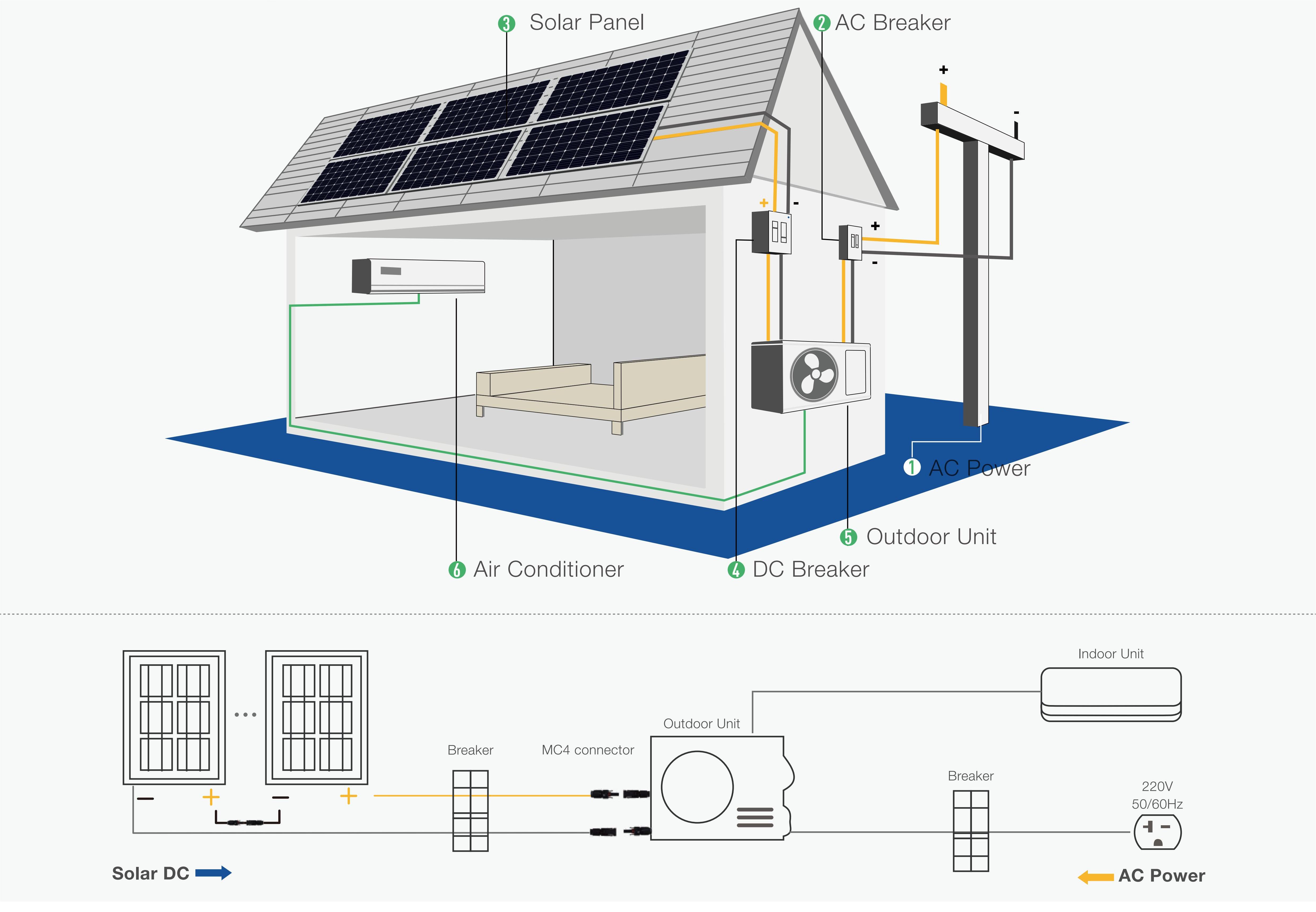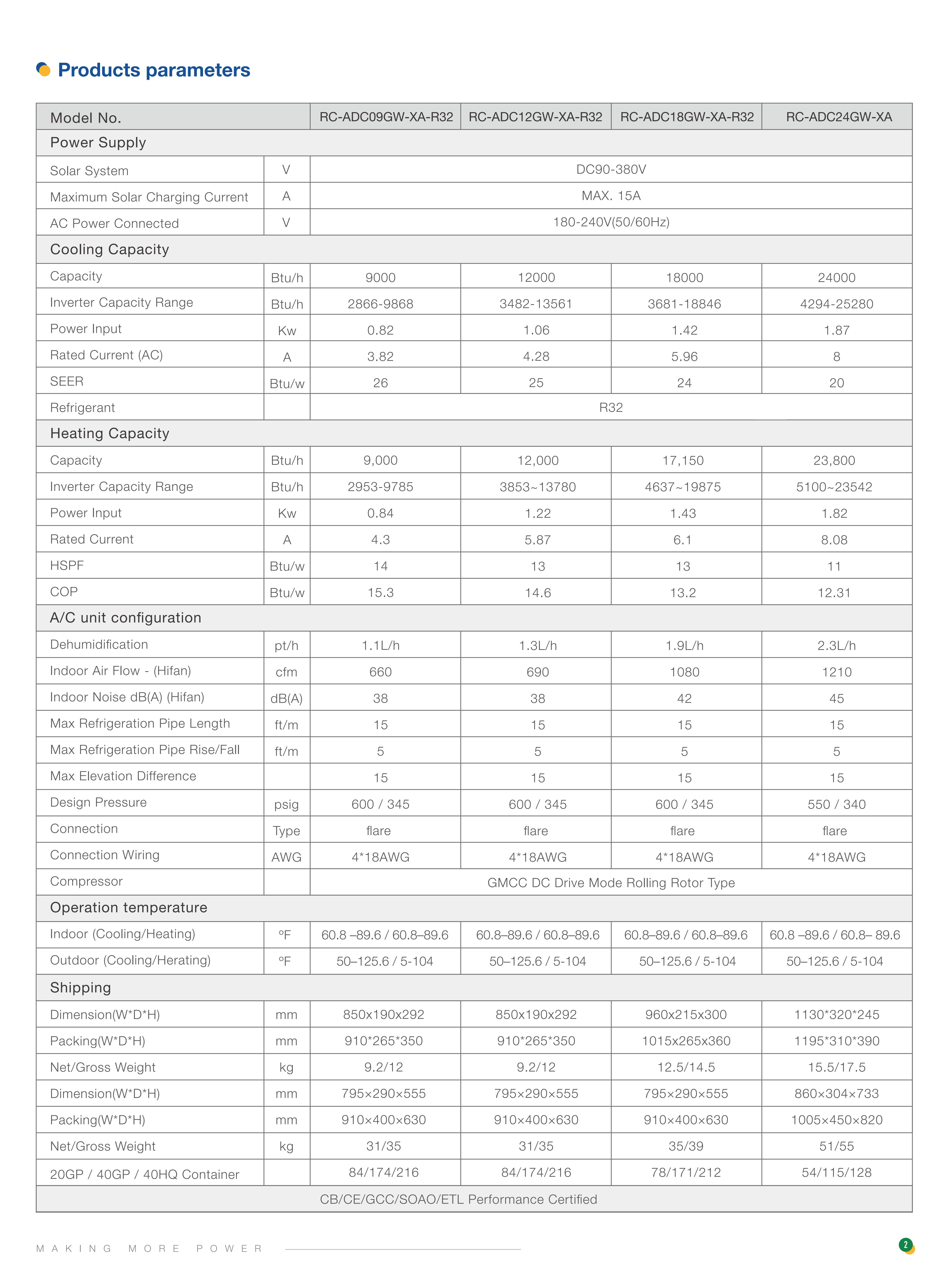Solar air conditioners, also known as photovoltaic air conditioners or solar-powered air conditioners, are air conditioning systems that utilize solar energy to power their operations.
It's important to note that the specific features and capabilities of solar air conditioners may vary depending on the manufacturer, model, and design. It's advisable to consult with an expert or manufacturer for detailed information on specific products.
Solar panel voltage:
DC90-380VMaximum Solar Charging Current:
15AAC Power Connected:
180-240V(50/60Hz)Refrigerant:
R32Compressor:
GMCC DC Drive Mode Rolling Rotor TypeConnection:
Flare
Here are some features commonly associated with solar air conditioners:
Solar Power Integration: The primary feature of a solar air conditioner is its ability to harness solar energy to power the air conditioning system. It typically consists of solar panels or photovoltaic (PV) panels installed on the roof or in a suitable location to capture sunlight.
Energy Efficiency: Solar air conditioners are designed to be highly energy-efficient, reducing dependency on conventional electrical grids and minimizing electricity costs. They often utilize advanced technologies and components to optimize energy consumption.
Off-Grid Capability: Solar air conditioners can be designed to operate independently from the electrical grid, making them suitable for remote or off-grid locations where access to traditional power sources may be limited. The system can store excess solar energy in batteries for use during times when sunlight is not available.
Cost Savings: By utilizing solar power, these air conditioners can potentially reduce electricity bills, especially in areas with high electricity rates or where cooling demand is significant. Over time, the cost savings from reduced energy consumption can offset the initial installation costs.
Environmental Friendliness: Solar air conditioners are environmentally friendly as they utilize clean, renewable solar energy, reducing dependence on fossil fuels and lowering carbon emissions associated with traditional air conditioning systems.
Durability and Longevity: Solar air conditioners are typically built to withstand harsh weather conditions and have a long lifespan. They are designed to operate reliably and efficiently for many years with proper maintenance.
Integration with Grid Power: Some solar air conditioners can be connected to the electrical grid, allowing for seamless operation when solar power is insufficient. This ensures uninterrupted cooling by automatically switching to grid power when needed.
Smart and Remote Control: Many solar air conditioners come with smart features and remote control capabilities, enabling users to monitor and control the system's settings remotely. This allows for convenient management and optimization of cooling needs.

Hybrid solar air conditioners main features:
Grid Independence: Hybrid solar air conditioners can operate independently of the electrical grid during daylight hours when solar power is available. This feature is particularly useful in areas with frequent power outages or in locations where access to the grid is limited, such as remote or off-grid installations.
Extended Lifespan: Solar air conditioners often have a longer lifespan compared to conventional air conditioners due to reduced energy consumption. As they rely on solar energy, the strain on the compressor and other components is reduced, resulting in less wear and tear and potentially extending the lifespan of the unit.
Return on Investment: While the upfront cost of a hybrid solar air conditioner may be higher compared to a traditional air conditioner, the long-term savings on electricity bills can lead to a faster return on investment. Over time, the energy savings can offset the initial investment cost, making it a financially viable option.
It's worth noting that the advantages and effectiveness of hybrid solar air conditioners may vary depending on factors such as geographical location, availability of sunlight, system size, and specific model and technology used. Consulting with a professional installer or manufacturer can provide more detailed information based on your specific circumstances.

How does a hybrid solar air conditioner working?
A hybrid solar air conditioner combines conventional air conditioning technology with solar power to provide cooling while minimizing energy consumption. Here's a general overview of how a solar air conditioner works:
Solar Panels: The system includes photovoltaic (PV) solar panels that convert sunlight into electricity. These panels are typically installed on the rooftop or in an area that receives ample sunlight.
Power Conversion: The electricity generated by the solar panels is converted from direct current (DC) to alternating current (AC) using an inverter. AC power is the standard type of electricity used in most homes and buildings.
Compressor and Refrigerant: Like a conventional air conditioner, a solar air conditioner uses a compressor and a refrigerant to cool the air. The compressor pressurizes the refrigerant gas, raising its temperature.
Heat Exchange: The hot, pressurized refrigerant moves to the condenser, which is located outside the building. The condenser dissipates heat from the refrigerant, causing it to condense into a liquid.
Expansion Valve: The liquid refrigerant passes through an expansion valve, which reduces its pressure. As a result, the refrigerant rapidly evaporates, absorbing heat from the surroundings, including the air in the building.
Evaporator and Air Circulation: The low-pressure, evaporated refrigerant enters the evaporator coil located inside the building. The warm air from the room passes over the coils, and the refrigerant absorbs the heat from the air, cooling it down. The cooled air is then circulated back into the room by a fan.
Recirculation and Temperature Control: The air conditioner continues to cycle and recirculate the air, maintaining the desired indoor temperature. The system may use thermostatic controls or other sensors to regulate the cooling process based on the user's settings.
Solar Power Integration: In a hybrid solar air conditioner, the AC power needed to run the compressor, fans, and other components is partially or entirely supplied by the solar panels. The direct current generated by the solar panels is typically converted to alternating current using an inverter before being used by the system. The solar panels offset the electricity consumption from the grid, thereby reducing the overall energy cost and environmental impact.
FAQs:
Q1: Do you support OEM/ODM?
A:Definitely, OEM&ODM service is supported with a certain quantity,including customize logo,package and label;
Q2: What's the production time?
A: The production time is normally 15 working days. but we will always prepare some stocks for popular models.
Q3: Can you provide DDP service?
A:Yes, if you are a personal customer and don't want to deal with the customs, we can provide DDP service to your address.
Q4: What about the warranty and how to claim?
A: Warranty period are 5 years since you receive the product, our professional after-sales team will deal with all warranty issues.